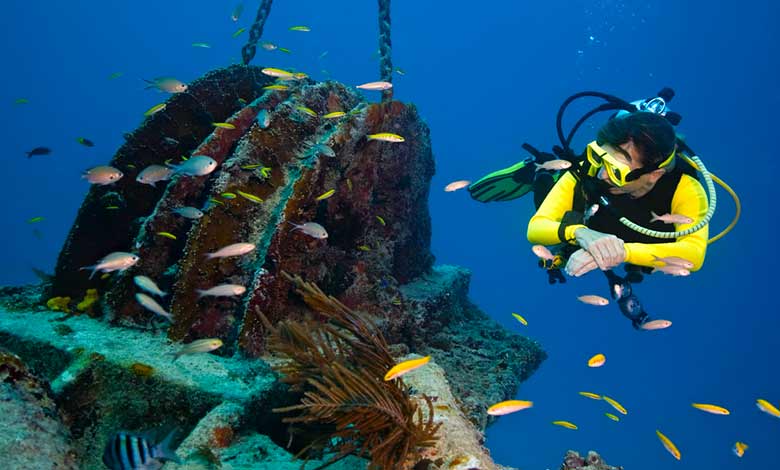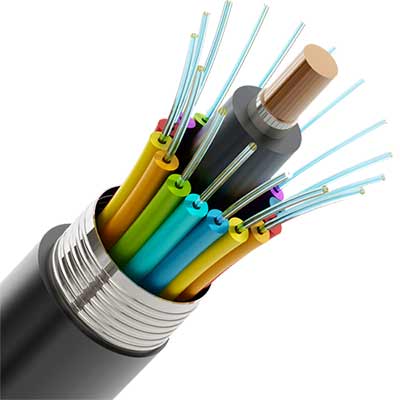
The internet is a physical network connected on land and under the ocean. About 300 undersea fiber optic cables are responsible for 99% of international data traffic. A solution needed to be found to connect everyone across the globe. After the invention of fiber optics, this technology soon spread worldwide. Fiber-optic lines are run from city to city on land. When crossing the ocean, a special cable and ship were needed to pull it.
Fiber optic submarine cables are part of the infrastructure that transmits almost all internet data worldwide. Internet adaptation has steadily increased over the last couple of decades. Despite its creation in the late 1960s, the internet was only widely adopted in 1989 after the invention of the WWW.
How do undersea internet cables work? (Fiber Optics Working Process)
When someone sends an email tweet, that data is sent through cables or, more commonly, radio waves to a router or cell phone tower. These signals are sent through a series of fiber optic cables pulses of light to an internet exchange.
Most data from users in a local area network pass through these hubs to connect to other networks. This journey will likely traverse the seabed for networks and data centers on the other side of the world. These submarine cables crisscross the ocean before arriving at an anonymous-looking building like this.
It’s called a landing station. It’s the end of the line for the submarine cable before the data begins its journey overland again. As soon as the cable is passed under the bows, the crew takes charge of it.
Fiber optics cable configuration
Data is transferred on fiber optics or these strands of perfect glass with light pulses. The bi-directional fibers are color-coded, with each color indicating a direction of data flow. Having a cable that lives in the ocean took some specific engineering. First, the fiber optic strands are the width of human hair and are coated with gel to keep them in place in this first layer of protection in a plastic tube.
Around the plastic tube are steel wires that add needed strength and protection. The next layer is copper, which strengthens and transfers power to repeaters. Repeaters are this canister-like device that amplifies the light every 50 miles or 80 kilometers. So the signal will make it to the other side of the ocean.
The final layer is made of plastic which insulates the entire package. This is the basic oceanic cable configuration. The cables are near shallow areas near shore or commercial fishing areas that need more protection. Two additional layers of galvanized steel capped with nylon thread and tar will be added for these areas. These cables are manufactured and spun in giant reels, which go into the pans of this large facility. So ships heading out to sea’ll have around a hundred pans to finish the job.
Undersea cables requirements
Most cables will last an average of twenty-five years. However, many retire early because the bandwidth capacities become too slow and obsolete. In addition, these submarine cables must comply with strict electrical standards to be installed underwater.
At depths of as much as 8000 meters to traverse the mid-Atlantic ridge, cables must be capable of handling extreme pressures. For example, the pressure at these depths is the equivalent of holding up an entire car with your thumb.
Additionally, the cables must account for rocky sea beds, marine animals, tsunamis, volcanoes, and even the occasional shark. As a result of these threats, most of the cable’s makeup is for protection. First, the cable starts with the optical fiber to break it down further, transmitting the data. These fibers are then coated with petroleum jelly for lubrication and kept firmly within the larger cable assembly.

The next layer is copper tubing, which provides protection and power for the cable. It is an active cable.
- Due to the extreme links of underwater internet cables, the light and the optical fibers must be boosted every 50 miles to amplify the signal and prevent data loss.
After these core layers, the remaining layers are strictly for protection. They include the polycarbonate layer, aluminum water barrier, steel wires, layer of mylar tape, and tar coding for ruggedness and protection.
Finally, laying the cable is equally as important as producing the cable. A special trawler ship carrying giant spools of Internet cables performs the laying and cable. Also, it is unreeling them as it passes from shore to shore.
Internet cables setup under the sea
When it’s time to load the ship carrying the cables out to sea, the cable highway pulls the cables into a large spool at the base of the ship’s hull. An entire crew working 12-hour shifts for a month is what it’ll take to get this ship ready to pull a new internet cable.
First, the ship will reach its starting location and get as close as possible to the beach. The cable has floated out to the shore and then buried in the sand. As the ship starts to leave the coast, a remote-operated plow will continue to bury the cable as the ship moves.
The first step to laying the cable requires an extensive survey of the seafloor to map the cable’s route. The reels will be unwound as the ship travels along the map after being loaded onto a hull in large spools.
Next, a sea plow is towed along the back of the ship to aid in bearing the cable a few inches below the surface for added protection. At the end of the installation process, extensive testing and inspection of the cable are performed before the cable is put into service.
Dense, rigid sea floors only require the cable to be buried small ways underneath. However, if the floor is soft and gooey, the plow must work harder to embed the cable much lower. Plows like the ROV – six can form this work up to 6,500 feet or 2,000 meters below the ocean’s surface. Robotic arms and Jets help put the cable into the ground, and treads allow it to traverse on the ocean’s floor. These robots are controlled from the comfort of the ship with small-scale replicas.
These ships have planned designated routes where the ocean floor is flat and smooth for easy placement. However, when crossing places like the Atlantic Ocean, the Atlantic Ridge is an underwater rocky mountain range that requires the cable to be reinforced.
Cables repair system
Do these cables have to be laid in one piece? Can they be repaired if damaged? Sharks have been known to bite and knot on them but don’t typically get through the cables. If they have been damaged, they can be repaired. When laying a new cable line, two ships are doing this job. One from either side, and they’ll meet somewhere in the middle. When they meet, the cables will be fused, which is the basics of our internet today.
In the late 1980s, Makai ocean engineering presented a solution with modern computers. Makai developed a rigorous 3d model of the cable called Makailay that accurately computed and displayed the cable shape and touchdown conditions in real time.
The MakaiLay model can consider the cable properties, all forces on the cable, the seabed contours, the ship maneuvers, and even ocean current readings from a current profiler in real-time during the lay. Operators use Makailay software to monitor and control the cable’s position and bottom tension, optimizing the vessel navigation and payout instructions for a safe and swift cable lay.
These two variables, position, and tension, are of the utmost importance for a cable. The Makailay controls the cable’s position and tension at any depth. During a lay, Makai lay gives the vessel and cable engine instructions to keep the cable right on track, and it retains a log of the as-laid path. In addition, a feature called Auto tension automatically adjusts cable payout and vessel navigation to keep tension within acceptable limits.
Conclusion
Today advanced 3d layouts and real-time metrics software called Makela is used when laying a cable. This accounts for the cable’s properties and forces applied to it within the location contour of the ocean floor with real-time ocean currents.
In addition, the software can precisely control the cable retrieval for repairs. Not only are internet cables hitting the ocean floor, but power cables transferring power from offshore renewable energy sources were predominantly from wind farms. Technology is increasing at a rapid rate.
More Articles:
GPS Coordinates Working Process
Table of Contents

